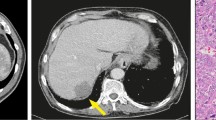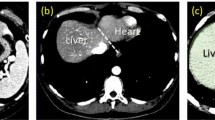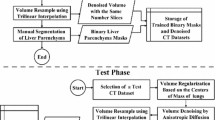Abstract
Purpose
Our aim is to develop an automatic method which can detect diverse focal liver lesions (FLLs) in 3D CT volumes.
Method
A hybrid generative-discriminative framework is proposed. It first uses a generative model to describe non-lesion components and then identifies all candidate FLLs within a 3D liver volume by eliminating non-lesion components. It subsequently uses a discriminative approach to suppress false positives with the advantage of tumoroid, a novel measurement combining three shape features spherical symmetry, compactness and size.
Results
This method was tested on 71 abdominal CT datasets (5,854 slices from 61 patients, with 261 FLLs covering six pathological types) and evaluated using the free-response receiver operating characteristic (FROC) curves. Overall, it achieved a true positive rate of 90 % with one false positive per liver. It degenerated gently with the decrease in lesion sizes to 30 ml. It achieved a true-positive rate of 36 % when tested on the lesions less than 4 ml. The average computing time of the lesion detection is 4 min and 28 s per CT volume on a PC with 2.67 GHz CPU and 4.0 GB RAM.
Conclusions
The proposed method is comparable to the radiologists’ visual investigation in terms of efficiency. The tool has great potential to reduce radiologists’ burden in going through thousands of images routinely.













Similar content being viewed by others
Notes
Body radiologists are specialists who have expertise in examining diseases of the gastrointestinal, genitourinary and cardiovascular systems.
References
Silverman PM (2003) Multislice CT in imaging the liver. Cancer Imaging 3:149–154
Silverman PM (2004) Liver metastases: optimizing detection with multislice CT (MSCT). Cancer Imaging 4:S1–S6
Francis IR, Cohan RH, McNulty NJ et al (2003) Multidetector CT of the liver and hepatic neoplasms: effect of multiphasic imaging on tumor conspicuity and vascular enhancement. AJR Am J Roentgenol 180:1217–1224
Kamel IR, Liapi E, Fishman EK (2005) Multidetector CT of hepatocellular carcinoma. Best Pract Res Clin Gastroenterol 19:63–89
Ronzoni A, Artioli D, Scardina R (2007) Role of MDCT in the diagnosis of hepatocellular carcinoma in patients with cirrhosis undergoing orthotopic liver transplantation. AJR Am J Roentgenol 189:792–798
Luca A, Caruso S, Milazzo M et al (2010) Multidetector-row computed tomography (MDCT) for the diagnosis of hepatocellular carcinoma in cirrhotic candidates for liver transplantation: prevalence of radiological vascular patterns and histological correlation with liver explants. Eur Radiol 20:898–907
Addley HC, Griffin N, Shaw AS et al (2011) Accuracy of hepatocellular carcinoma detection on multidetector CT in a transplant liver population with explant liver correlation. Clin Radiol 66:349–356
Bilello M, Gokturk SB, Desser T et al (2004) Automatic detection and classification of hypo-dense hepatic lesions on contrast-enhanced venous-phase CT. Med Phys 31(9):2584–2593
Milizer A, Hager T, Jager F, et al (2010) Automatic detection and segmentation of focal liver lesions in contrast enhanced CT images. In: International conference on pattern recognition, pp 2524–2527
Pescia D, Paragios N, Chemouny S (2008) Automatic detection of liver tumors. In: International symposium on biomedical imaging, pp 672–675
Masuda Y, Foruzan AH, Tateyama T, et al (2010) Automatic liver tumor detection using EM/MPM algorithm and shape information. In: International conference on software engineering and data mining, pp 692–695
Masuda Y, Tateyama T, Xiong W, et al (2011) Liver tumor detection in CT images by adaptive contrast enhancement and the EM/MPM algorithm. In: The 18 th IEEE international conference on image processing, pp 1421–1424
Mekada Y, Wakida Y, Hayashi Y, et al (2006) Spatiotemporal density feature analysis to detect liver cancer from abdominal CT angiography. In: Asian conference on computer vision, pp 702–711
Acharya T, Ray AK (2005) Image processing: principles and applications. Wiley-Interscience, London
Liu J, Huang S, Nowinski WL (2008) A hybrid approach for segmentation of anatomic structures in medical images. J CARS 3:213–219
Chi Y, Liu J, Venkatesh SK et al (2011) Focal liver tumor detection and classification using content-based image retrieval. In: Proceedings on SPIE, 7963
Chi Y, Liu J, Venkatesh SK et al (2011) Segmentation of liver vasculature from contrast enhanced CT images using context-based voting. IEEE Trans Biomed Eng 58:2144–2153
Frangi A, Niessen W, Vincken K, et al (1998) Multiscale vessel enhancement filtering. In: Medical image computing and computer-assisted intervention—MICCAI’98, pp 130–137
Smith LI (2002) A tutorial on principal components analysis. http://www.cs.otago.ac.nz/cosc453/student_tutorials/principal_components.pdf
Sims JR, Gharai LR, Schaefer PW et al (2009) ABC/2 for rapid clinical estimate of infarct perfusion, and mismatch volumes. Neurology 72:2104–2110
Fleiss JL (1971) Measuring nominal scale agreement among many raters. Psychol Bull 76(5):378–382
James K, Eisenhauer E, Christian M et al (1999) Measuring response in solid tumors: unidimensional versus bidimensional measurement. J Nat Cancer Inst 91:523–528
Chakraborty, D (2011) The ROC task. http://www.devchakraborty.com/Receiver%20operating%20characteristic.pdf
Zhang X, Fujita H, Qin T et al (2008) CAD on liver using CT and MRI. Med Imaging Inform 4987:367–376
Acknowledgments
This research work is supported by a grant (Grant No. JCOAG03_FG05_2009) from the Joint Council Office, Agency for Science, Technology and Research, Singapore.
Conflict of Interest
None.
Author information
Authors and Affiliations
Corresponding author
Rights and permissions
About this article
Cite this article
Chi, Y., Zhou, J., Venkatesh, S.K. et al. Computer-aided focal liver lesion detection. Int J CARS 8, 511–525 (2013). https://doi.org/10.1007/s11548-013-0832-8
Received:
Accepted:
Published:
Issue Date:
DOI: https://doi.org/10.1007/s11548-013-0832-8




